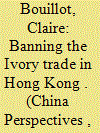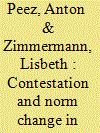|
|
|
Sort Order |
|
|
|
Items / Page
|
|
|
|
|
|
|
| Srl | Item |
| 1 |
ID:
166093


|
|
|
|
|
| Summary/Abstract |
The date of 31 January 2018 marked the adoption in Hong Kong of a three-phased law banning trading in elephant ivory that will come into full effect on 31 December 2021. This follows the decision of mainland China outlawing this practice from 31 December 2017. These new ordinances, which derive from an international convention (CITES), are particularly adapted to these places as they represent (with Japan) the world’s principal destination of ivory, both legal and illegal, and have done so since the 1950s. This trade, and especially its illegal strand, threatens the survival of Africa’s elephants, whose ivory is regarded as precious. In Hong Kong, the movement of ivory is regularly in the news. July 2017 recorded the largest seizure of illegal ivory in the past 30 years (7.2tonnes). Early 2018 was also noteworthy on account of two events: on the one hand, the resignation of a member of the governmental consultative committee on endangered species (who is also an ivory trader), who had been selling illegal ivory, thus lending a whiff a scandal to the legislative process; and on the other hand, the killing in Nairobi of Esmond Bradley Martin, one of the leading experts on the trafficking of ivory. These national and international events, together with scientific studies and various other reports, have been part of the context of legislative reform in Hong Kong. They are an indication of the complex nature of the issues involved, as can be seen in the stormy legislative debates brought about by competing interests. Quite a number of local newspaper articles (in English and Chinese alike), as well as the (English-language) press in mainland China,have covered this reform by exposing the tensions, divergent points of view, and arguments of the protagonists. It might still appear, however, that there has been little discussion of certain points. The present article will highlight, through an analysis of the media’s treatment of the legislative reform process in Hong Kong, the political issues at stake in this ban, and in particular the grey areas of the public debate. It tries to break with the dichotomy “for” or “against” that are often typical of debates on the extinction of these emblematic mammals. In this press review I undertake a detailed analysis of local newspaper articles, essentially those of the English-language press. Of the 41 articles examined, I selected 21 on the basis of their relevance to legislative reform in Hong Kong and the diversity of their content. Two articles from the Chinese-language local press (selected from 28 articles), as well as six articles from the mainland’s English-language press (selected from 47 articles) serve to underscore this analysis. These articles were published between 2015 and July 2018, that is, from the announcement of the reform until its initial implementation. This article will refer to the timeline of the reform with respect to several key moments and questions that require particular attention.
|
|
|
|
|
|
|
|
|
|
|
|
|
|
|
|
| 2 |
ID:
185245


|
|
|
|
|
| Summary/Abstract |
Elephants and whales took center stage in the environmental movements of the 1980s. As flagship species, they were the poster children of global initiatives: international ivory trading and commercial whaling were banned in the 1980s in the context of the Convention on International Trade in Endangered Species of Wild Fauna and Flora (CITES) and the International Whaling Commission (IWC), respectively. While the conservation of both species is contested, we observe a change of existing norms in one case but not in the other: A moratorium on commercial whaling remains in place. Meanwhile, a limited shift to sustainable use regarding ivory was passed in 1997/2000. We ask why norm change occurred in one case but not the other, given their similarities. We argue that the difference can be explained by the perceived legitimacy of the claims of norm challengers using arguments of “affectedness” and the breadth of issues covered by CITES. In contrast, other factors commonly discussed in norms research do not explain this puzzle: the relative power and strategies of norm advocates and challengers, and the degree of legalization. This shows the interplay of discursive aspects and concrete institutional opportunities for norm change, even in the face of otherwise inopportune conditions.
|
|
|
|
|
|
|
|
|
|
|
|
|
|
|
|
| 3 |
ID:
186139


|
|
|
|
|
| Summary/Abstract |
This study explores the conditions under which China complies with the international norms of banning the trade in endangered species using tiger bones and ivory cases. Why did China ban the ivory trade but attempt to allow the trade in tiger derivatives? The authors traced the key policies formulated by Chinese policymakers during 1981–2018. Drawing upon norm localization theory, the authors find that domestic policy preferences played a key role in linking domestic and international norms. Chinese policymakers actively chose ideas to advance their policy preferences, and this localization process reaches beyond a static fitting process between domestic-international norms. This finding has implications for wildlife policies in developing countries and sheds light on China’s wildlife policy development following the outbreak of coronavirus.
|
|
|
|
|
|
|
|
|
|
|
|
|
|
|
|
|
|
|
|
|